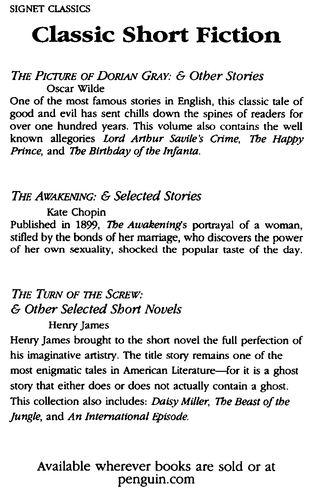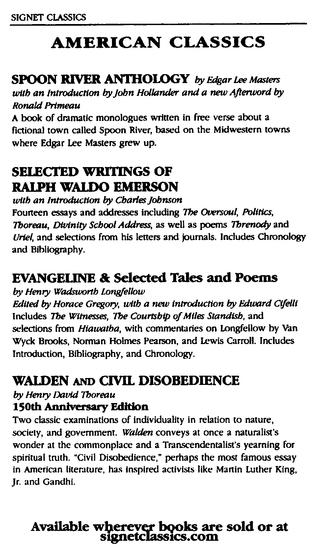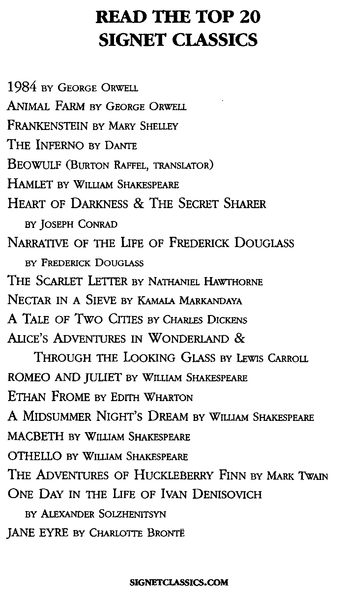41 Stories (61 page)
Authors: O. Henry

But O. Henry was. O. Henry designed his stories around the establishment and solution of the problems of his characters. In this way, he's continued to please readers who might detest the open-endedness of modern stories.
O. Henry made sure his characters could be understood by a broad range of readers, for he had his own mission: to connect his readers with a particular type of character, the uneducated (or self-educated) but natural man who sees clearly while those richer and better educated, more fortunate in every way, are blind. He made devastating fun gently, so that even the pompous, the pretentious, and the selfish live to see another day.
In his fiction, O. Henry often used places he'd really livedâthe Texas of ranches and its capital, Austin; the American South; Latin America; New Orleansâbut O. Henry's own life, unlike his fiction, was full of insoluble problems: incurable disease, poverty, debt, imprisonment, the deaths of his wife and infant son. As a writer, he chose deliberately to idealize and recolor human suffering. In the world of his stories, a plot working out was a way of giving his readers relief from their own lives. If O. Henry made everything in a story work out, often at the cost of verisimilitude, it was a price his readers were more than happy to pay. Until the end of his life, O. Henry eschewed writing in a realistic vein, and he preferred to twist events to create a world that was recognizable and yet comforting for his readers.
Only when he was too ill and exhausted to write at all did O. Henry express regret for the waste of his talent and think about writing a different kind of fiction, closer to the life he'd actually led.
Â
William Sidney Porter was born on September 11, 1862, in Greensboro, North Carolina. Before he was three, his mother was dead of tuberculosis. His father, a physician and heavy drinker, gave up the practice of medicine and earning an income to invent a perpetual-motion machine. The care of Dr. Porter's two children, Will and Shirley, was left to their grandmother and their aunt Lina, who ran a local school. In his youth, Porter was poor. If he wasn't precisely neglected, he wasn't wanted as he might have been by his mother, had she lived, or by his father, if he hadn't succumbed to obsession and alcoholism. In his childhood, Porter was dependent on the kindness of relatives and friendly families, and he lived a kind of orphanhood that made him dreamy and a little passive, or at least willing his whole life to accept the generosity of othersâhis father-in-law and his friends who extended themselves and their resources to support him.
This is not to say that Porter didn't try. By the time he was fifteen, he was working at his uncle Clark's store, W. C. Porter and Company Drug Store. At nineteen, he was a licensed pharmacist. He was rescued from being trapped in a small-town drugstore when, in March 1882, Dr. and Mrs. Hall took him along to South Texas, where they were visiting their four sons. The Hall family, plus the Harrell family, with whom Porter lived in Austin when he left the Hall ranch, provided him with homes and emotional support, and gave him a chance to read as many books as he could get his hands on, to learn about the Texas countryside and its people, and eventually, to secure jobs in the Texas Land Office and at the First National Bank of Austin. That they did so is testimony not only to their kindness and generosity but to what must have been Porter's considerable charm and promise. Those were days of landgrabs and the piling up of wealth in Texas, but Porter was unable to gain material security. His luck in life, if he had any, lay in human relations and his ability to communicate what was worthwhile in people.
In Austin, he fell in love with and married Athol Estes; worked in the Land Office; performed in Gilbert and Sullivan's Mikado; started his own paper, The Rolling Stone; and eventually worked at the First National Bank, which was the undoing of his Austin life. The disastrous combination of Porter's unsuitability as a bookkeeper and the looseness of Texas banking practices ended in 1896 in his indictment for embezzlement. He fled Texas, first for New Orleans and then for Honduras, finally returning to Austin because Athol was dying of tuberculosis. He was convicted and sent to the federal penitentiary in Columbus, Ohio, to serve a term of five years, of which he ended up serving three. In prison he worked in the pharmacy, and soon was trusted enough to be allowed to sleep at the pharmacy rather than in a cell. He and an old acquaintance, a bank robber, formed a group of friendsâembezzlers, train robbers, and one forgerâand they called themselves the Recluse Club. Porter was gathering material, as he always did, and he was also writing, more than ever. Humiliated by his imprisonment, a widower and absent father to his daughter, Margaret, he poured his failure and loss into the hard work of being a productive writer. He sent his stories out to magazines and newspapers, and left prison a published writer with a new name, that of O. Henry.
Released in 1901, he moved to New York City, and there he found the home of his heart. In the universe of New York, O. Henry could find all the stories he could write, more than enough editors who wanted his work and would pay in advance, and perhaps most important, a combination of friends and anonymity. He avoided confidences about his past, even with close friends.
O. Henry's second marriage, in late 1907, to Sara Cole-man, an old sweetheart from Greensboro, was not happy. He'd lived too long on his own in hotels and boarding-houses, and his financial insecurity and unrelenting drinking habits would have been hard to take, along with his need to be by himself. O. Henry died in New York City on June 5, 1910, months before his forty-eighth birthday, of diabetes and cirrhosis of the liver, and perhaps also of exhaustion. He'd worked for years at a killing pace, always on deadline, always behind. However much he wrote, however much he was paid, O. Henry gave away and spent all that he had and more. Many of his characters seek money, but few find it, and even if they do, it's likely to evaporate sooner rather than later. Money, as much as or even more than love, is the Holy Grail of his storiesânot surprising since O. Henry spent his life in pursuit of it. For him it always remained a will-oâ the-wisp.
2
2

As a master of plot, O. Henry deliberately twisted his endings to establish a symmetry rarely seen in life. One of the most appealing things about an O. Henry story is its demonstration of balance in an unjust world.
O. Henry starts “The Last Leaf,” included in the present collection, with a lively description of Greenwich Village, a section of New York where the “art people” live on winding streets in a quaint place of “north windows and eighteenth-century gables and Dutch attics and low rents.” The last phrase makes the quartet of descriptives vintage O. Henry; what he elevates in idealized terms, he brings back to earth with a reminder of the insoluble, ever-present problem of money.
“At the top of a squatty, three-story brick,” two young artists live: Johnsy, or Joanna, and Sue. Sue came to Greenwich Village from Maine, Johnsy from California; they met and decided to share a studio.
It is a cold, unforgiving winter, and Johnsy has pneumonia. The doctor doesn't hold out much hope for her; Johnsy is waiting for death, and the doctor tells the faithful Sue, “ âWhenever my patient begins to count the carriages in her funeral procession I subtract 50 per cent from the curative power of medicines. If you will get her to ask one question about the new winter styles in cloak sleeves I will promise you a one-in-five chance for her, instead of one in ten.' ”
Johnsy lies in bed, staring out the window, counting backward. “An old; old ivy vine, gnarled and decayed at the roots, climbed half way up the brick wall.” There are only five leaves left on the vine and, Johnsy tells Sue, “ âWhen the last one falls I must go, too.' ” She refuses fortifying wine and nourishing food. She desires nothing that will keep her in the world, and wants to see the last leaf fall. “ âI'm tired of waiting,' ” she says. “ âI'm tired of thinking. I want to turn loose my hold on everything, and go sailing down, down, like one of those poor, tired leaves.' ”
The cleverness in the story rests in the establishment of a seemingly insoluble problem. There's no way to control the falling of leaves, or the death of a friend, however much Sueâand the readerâwishes to. Johnsy is young and talented. It's unjust that she should give up and die. Most important, her death matters to Sue.
Enter salvation in the form of Behrman, an old German painter who speaks in a vaudeville dialect and lives in the same building as Johnsy and Sue. Behrman has been talking forever about painting his masterpiece but never touches the blank canvas that's rested on his easel for twenty-five years. Sue persuades him to pose for an illustration so she can earn money for Johnsy's care. She tells him of Johnsy's fancy that she'll die when the last leaf falls, and he declares, “ âIs dere people in de world mit der foolishness to die because the leafs dey drop off from a confounded vine?' ”
That night there's a terrible storm, but in the morning, when Sue raises the blind, the last leaf is still on the vine. Another night, another storm, and still the leaf persists.
Johnsy rallies, deciding, “ âSomething has made that last leaf stay to show me how wicked I was. It is a sin to want to die. You may bring me a little broth now, and some milk with port in it, andâno; bring me a hand-mirror first....' ” The reader cheers up, remembering the doctor's statement, and agreeing that nothing is more of this world than an interest in one's appearance.
When Johnsy is well enough to leave her bed, Sue tells her that Behrman has died of pneumonia. During the dreadful night of the first storm, he carried a lantern up a ladder to provide light while he painted the last leaf on the brick wall. He painted the last leaf so beautifully that Johnsy never noticed that the leaf didn't move in the wind and rain.
“ âAh, darling,' ” says Sue, “ âit's Behrman's masterpieceâhe painted it there the night the last leaf fell.' ”
The ending of “The Last Leaf” is sad and completely satisfying. The seemingly impossible problem is solved; the real leaf fell but couldn't kill Johnsy. The gears of injustice are jammed, not for supernatural reasons but by the effort of an old man, whom everyone thought a failure. Best of all, Behrman has painted his masterpiece at last.
For a moment the world is balanced and fair, and so it will remain until the reader enters O. Henry's next tale.
âLAURA FURMAN



Other books
The Driver's Guide to Hitting Pedestrians by Prunty, Andersen
The Long Road to Gaia by Timothy Ellis
Unafraid by Cat Miller
The Undertow by Peter Corris
SNOW KISSED CHRISTMAS: Sweet Historical Romance Novella--Short Read by Hutchinson, Bobby
Single White Vampire by Lynsay Sands
Dreams of Her Own by Rebecca Heflin
Harry Flashman by George MacDonald Fraser
The Quarterback's Love Child (A Secret Baby Sports Romance Book 1) by Stephanie Brother
Alex by Pierre Lemaitre